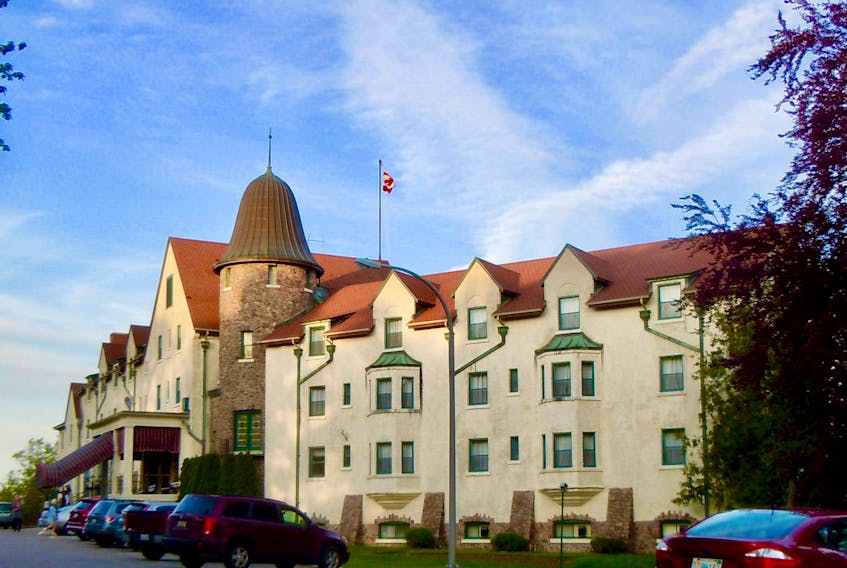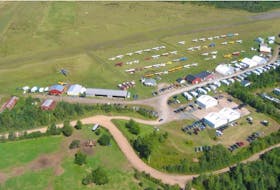Two of the region’s iconic resorts are celebrating anniversaries this year. The Algonquin Resort in St. Andrews-by-the-Sea is 130 years old, making it the oldest resort in Canada east of the Rockies. The Digby Pines is 90 years old.
The Algonquin is a rambling Tudor-style resort, while the Pines plays homage to the region’s Acadian heritage with a Norman chateau style of architecture.
The Pines is a legacy of the heyday of grand railroad construction, which saw the Canadian Pacific and Canadian National railways populate communities across Canada with all manner of fanciful chateaus, manoirs, castle and lodge-style hotels as a way to encourage tourism.
The railways also realized Canadians were a golf-mad nation (we have the highest golf participation rates in the world) and so commissioned top designers to create legendary courses. Canada’s most famous golf designer, Sir Stanley Thompson was knighted for his contribution to golf. At Banff he built the first golf course in the world to cost a million dollars. Later he came to Digby and working with the landscape, crafted a delicious parkland course that challenges, but doesn’t beat a player up. Locals laughingly say you can play down the middle of the fairway and never have a flat lie.
My most recent stay I was reminded how visually appealing a course it is. And had a chuckle on the par 4 11h hole, reading that the great Babe Ruth (honestly, it’s astonishing who stayed at and played the Pines) used his driver, nicknamed The Bludgeon to make the green. This is also the hole where Thompson placed one of his signature features: a question-mark-shaped bunker.
Another Thompson tell-tale is The Pines’ par three second hole. It is reminiscent of the fourth hole, the Devil’s Cauldron at the Banff Springs course. (Fortunately, green fees in Digby are about $200 less than Banff.)
What I like about the Pines – hotel and course – is how they have adhered to tradition and style. The chateau is no cookie cutter modern construction. There’s a sense of arrival at the main foyer, off of which is a lounge with fireplace big enough to stand in and bright sunroom overlooking the grounds, pool enclosure, spa and to Digby Gut below.
The resort offers bedrooms and suites in the chateau as well as grounds dotted with one, two and three-bedroom cottages, which have verandas and living rooms with wood-burning fireplaces. On the warmest nights of summer you’ll often see a thin line of smoke from the chimneys as guests settle in to their somewhat romantic getaway.
For those who haven’t been in a while downtown Digby is lined with gift shops, restaurants and cafes overlooking the scallop fleet. For dinner I stayed at The Pines. The Valley is loaded with great, just picked, harvested, or caught produce, protein and seafood, but The Pines chef, Dale Nichols, who has overseen their kitchens for a decade, has elevated the culinary experience beyond the usual summer fare.
Since this is Digby I indulged in scallops risotto for an appetizer, followed by Coquilles St. Jacques. Normally I wouldn’t order two similar dishes for a meal, but I know from previous work that scallop risotto is the most popular dish on the menu, and as an appetizer I expected a much smaller serving than I got. The coquille was thick with massive sea scallops. Nichols’ dishes aren’t mean in portion size. To close, I opted for the fresh, light-sounding pear poached in lavender. This meal was the perfect self-indulgence, so if you’re celebrating anything (anniversary, birthday, marriage, graduation, promotion, tax return) this is the place to do it.
The other constants about The Pines are manager Rene LeBlanc, he’s been here 21 years, and the fact that for 67 of the course’s 90s years, there has been a Nickerson (Charles, Bill and Scott) as the course pro. This personal passion for the place translates into the guest experience.
Other local diversions are the Admiral Digby Museum, whale watching from nearby Brier Island, visiting the Balancing Rock and site of Maud and Everett Lewis’ original home. Just below The Pines is the terminal for Fundy Rose ferry to Saint John, convenient for those heading to St. Andrews.
I first went to St. Andrews in October 1978 for a newspaper convention. I was shocked that we had anything like the Algonquin in our backyard. Its towers and turrets seemed at odds for Maritime practicability. I so enjoy the resort, the golf and the town than since that first business meeting I have returned to St. Andrews 39 times.
The Algonquin was originally built to cater to wealthy Bostonians who arrived by private rail cars with servants in tow. They were part of the rusticator holiday movement which believed that fresh air and seaside breezes would cure any aliments.
To mark this anniversary the Algonquin hired Rod Whitman, who designed the Cabot Links, to refurbish their golf course. This is the third evolution of golf at the resort. The original course played inland and was very dry. To celebrate the millennium, Canadian designer Thomas McBroom was given $7 million to re-imagine the course. McBroom took the course from 27 holes to an 18 in a hybrid parkland/links design that turned play around to follow Passamaquoddy Bay towards the town.
According to the Algonquin’s director of golf, Charlie Martin, Whitman’s refurbishment created “two entirely new holes from tee to green, the 10th and 11th as well as five other brand new green sites and four new tee sites. “On top of all of these changes, every bunker on the course is brand new, with the exception of the green side bunkers on 9 and 18.”
The refurbishment also meant removing over 10,000 trees and bushes to open up the views of the bay and giving some holes a links-like feel.
Like the Pines, the Algonquin culinary team re-interpret local items to present ideas like blueberry salmon gravlax, blueberry pastrami salmon and other variations with beef, lamb, scallops, oysters and lobster. My weakness is their lobster eggs Benedict served in the Van Horne Veranda, which must be the sunniest breakfast room in Canada.
My two other culinary stops are Something’s Brewing Cafe by the waterfront, where a young chef from Amherst has created my new favourite summer dish: maple hot smoked salmon bruschetta, with blueberry chutney and pickled asparagus, and The Gables.
The Gables is the oldest restaurant in St. Andrews. It’s your usual seaside pub grub with buckets of mussels and lobster and a waterside patio. When the sun sets staff hand out fleece blankets to fight the chill, giving the place the feel of an adult sleep over. I love the casual, practical Maritime feel of this.
My other favourite stop in St. Andrews is Minister’s Island. It’s a tidal island, reached by driving across a sandbar at low tide. It was the summer estate of Sir William Van Horne, the man who completed the railway across Canada. Long before anyone considered lifestyles of the rich and famous, Van Horne lived large. He built a 50-room cottage on the island, a three-story bath house, the largest wooden barn in Canada and operated a farm on the estate. When Van Horne was back at his Montreal mansion fresh milk, eggs, butter and produce were sent by overnight train for his breakfast.
Like those early rusticators, I always leave feeling renewed by my visits to either of these historic resorts.
If you go:
Both resorts have various anniversary-themed specials packages on offer. Check their websites: digbypines.ca and algonquinresort.com.









